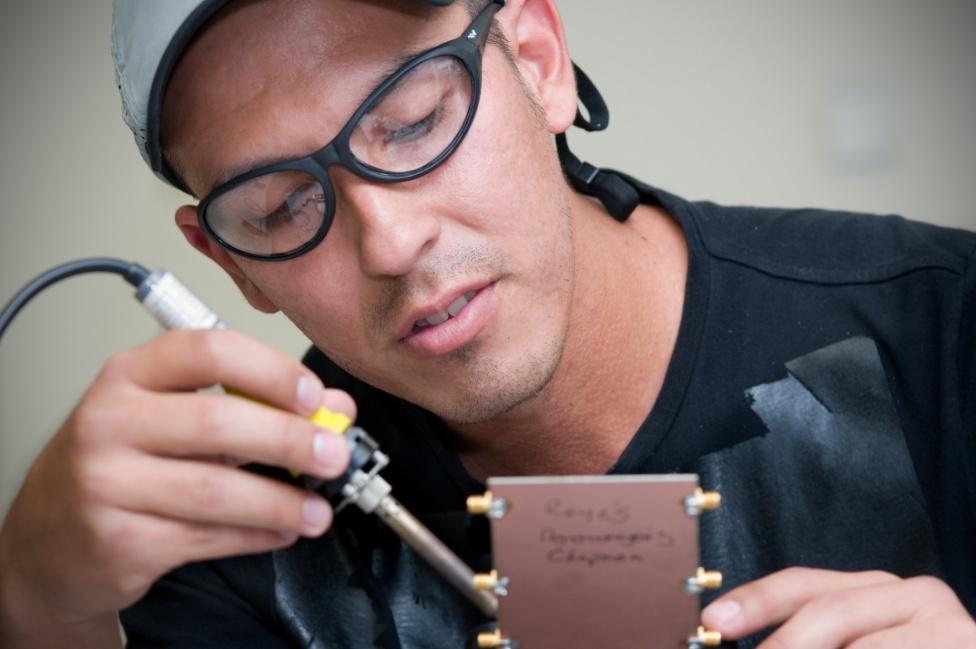
Lab Highlights
- The lab was founded using funds from alumni and a generous industrial sponsor, SAWTEK, Inc.
Lab Courses
- EE 4350 - Applied Electromagnetics: RF Systems
With donations from alumni and SAWTEK, Inc., the Edwin “Burt” McNeil RF/Communications provides students the opportunity to design and test high frequency systems used for wireless applications. Students are able to use a network analyzer, Agilent's PNA-L Series - designed for S-parameter and simple nonlinear testing of passive components. The lab gives students the ability to simulate on PC's using Matlab to design RF matching networks, microstrip line filters, and RFID tags. Students are able to assemble the designs using components and hardware in the lab. The students use the network analyzer to test their design. Students can also save data from the analyzer to import into their original Matlab simulations to compare the accuracy of their simulation with the actual results.
Analog and Digital Communication: This is a senior level lab that uses Telecommunications Instructional Modeling System (TIMS) manufactured by EMONA Instruments. TIMS is a flexible and versatile communications trainer that incorporates all of the instruments needed to quickly and easily carry out experiments in analog and digital communication.
TIMS allows students to build telecommunications systems using a functional-block approach. That is, individual modules that perform functions such as multiplication and addition of signals, filtering, noise generation, etc., are inserted into a mainframe and connected using cables to form complete communication systems or subsystems. The prominent advantage of such an approach is that it mimics the methodology we use in class to teach communication concepts. We start with a block diagram in which each communication module is represented by a black box and then move on to study technical details of each block. Students can therefore get a clear picture about what modules they are going to employ in order to set up a communication system based on the block diagram approach they have studied in class and the mathematical description of these blocks. We have three sets of TIMS modules that can be used to set up three stations for experiments in both analog and digital communication courses. These include modulator and demodulators (AM, FM, ASK, FSK, PSK, QAM, etc), line coding, PCM encoder/decoder, CDMA decoder, channel filters, and noise generator.
RF Systems and Circuits: This is a senior level lab where students are introduced to the unique challenges of high frequency, also known as radio frequency (RF) systems analysis and design. Students are able to take high frequency measurements up to 6 GHz using an Agilent network analyzer. The analyzer is capable of making frequency domain and time domain measurements, giving students the opportunity to discover the practical importance of Fourier transforms. Students are also able to display Smith charts using unique RF network parameters. These analysis tools are essential for students to grasp the circuit theory that is present only at higher frequencies.
Many different devices operating from 70 MHz up to 2 GHz have been provided by TriQuint Semiconductor (Orlando, FL) for students to measure and test against specifications. Students learn how to accurately take RF measurements using one and two port calibrations.
Once the analysis phase is complete, students can then begin to design RF circuits and systems. Design projects include discrete component and microstrip line filters, discrete and stub line matching networks, transmission line design, quarter and half wavelength transformer design. There are two soldering stations for assembly, and four PC's in the lab where students can solve problems and simulate designs using MATLAB. Last semester students successfully designed a 2 GHz, fifth order maximally flat low pass microstrip line filter that was fabricated by Advanced Circuits. Their design was shipped in two weeks and students were able to test their filter before the end of the semester.